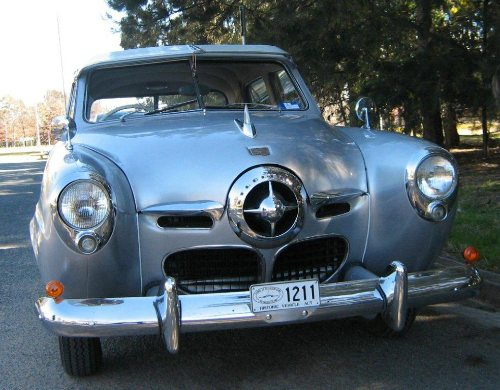A very long tale of a distinctive tail.
My ‘coming or going’ 1950 Studebaker Champion started off with my going to a clearing sale in 1988 out back of Crookwell and picking up a collection of bits for $10 that had some useful looking grease guns visible on top. In the bottom I found all the bits for a shotgun and being an avid gun collector I assembled it and found the problem to be a bent firing pin. Keith Blundell made me one from a Ramset bolt and then I swapped the gun for a pilothouse De Soto utility. I then swapped this for a Morris Minor that I thought my daughter would appreciate for her 18th but she had her eyes on a Datsun 1600, much sportier!
During all this I had spied what I thought looked like a Tucker in Queanbeyan but it turned out to be a complete Studebaker left behind by the owner with a friend. This friend hankered after the Minor. At this stage I had to put $500 cash in and came to own a complete, if rusty in the boot, Studebaker. A long trail from that original grease gun!
This car could well be the one you used to see in the early 70s not far from the coast road in Bungendore but what I got was completely stripped down with all the bits in boxes or stored in the body shell. It was not my first Studebaker having had a ’35 Dictator (Studebaker dropped this name the next year due to its association with Herr Hitler)
I finally got it on the road in 2011 having also fully restored my 1935 Chev Standard roadster and the ’35 Austin 10 over the last 10 years. They join the Nash Ambassador that was on the ’87 Rock Run (Uluru). Helen has been pestering me ever since for a story on this quite unique car with its wraparound rear window. Its restoration has taken place over 35 years with even little items like manufacturing a gear lever knob taking place over months. The knob is made up of Dev Con 2 pack just about set being drawn over a nut and bolt of the correct thread for the lever. After being baked in the sun on the shed roof for a couple of months, the bolt had its head cut off and was inserted in a drill run very slowly. Using a file it was then shaped to how I wanted it with a file. Purists assert it is not correct but I don’t have much time for their views.
The Studebaker has a 2.8l side valve 6, self-adjusting brakes and an overdrive gearbox behind the 3 speed box. This is operated by cable from a dashboard control. It also is cut out by an electrically operated accelerator kick-down. Radio and clock are standard but a heater was optional.
In restoring the only mods I deemed necessary were to put in a 12V system instead of the 6V. The generator has been replaced by an alternator and I have replaced the indicators contained within the park lamps with separate amber flashers. On the road the car is not gutsy but will sit on 110kmph OK. The brakes are great with no external boost necessary.
The Studebaker company evolved out of one of 5 brothers who made a good pile out of selling wheelbarrows to the ‘49ers in California’s gold-rush. After wagons the first cars were in association with other companies with Studebaker selling them through its extensive wagon dealer network. Some of these vehicles were disasters and when Studebaker bought the others out they made sure of quality. They continued to build good products but profits were hard to come by after the war and the last Studebakers came out of Canada in the mid 60s. Larks, however, were also produced in Melbourne and were popular as police cars in the early 60s with Canberra having a few and the Victorian police using supercharged versions as very fast pursuit cars.
Charlie Adams
Thanks to Harry Crawford

